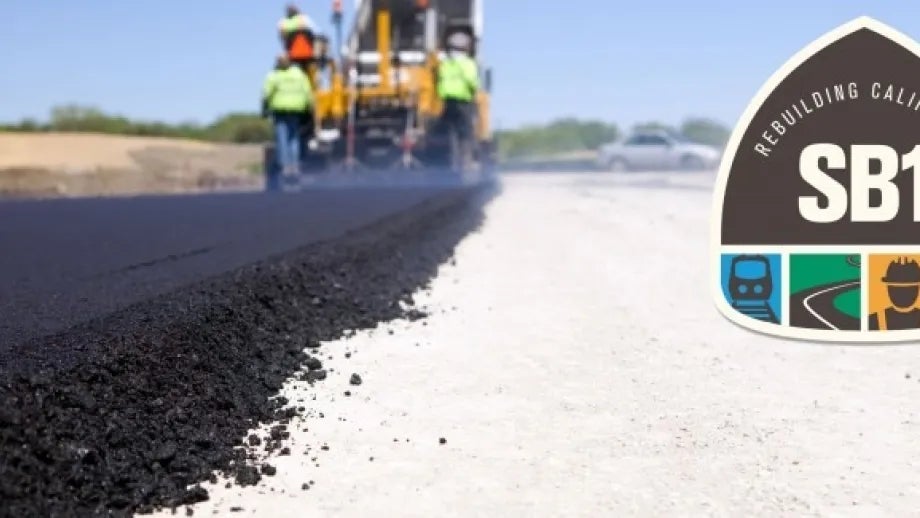New Generation of Roadway Repair on Tap for California
The calendar’s turn to November brings with it a first-in-a-generation infusion of funds to restore, renew and repave the Golden State’s aging and long-neglected streets, roads and highways. The new wave of investment is spurred by state Senate Bill 1, which was authored by state Senator Jim Beall of San Jose and signed into law this April by Governor Brown.
Beginning November 1, 2017, SB 1 is forecast to generate more than $5 billion in the Bay Area — and some $54 billion statewide — over the next 10 years. Statewide, about half will go to cities and counties to repair local streets and roads, supplement local dollars for new transportation projects, and advance local planning initiatives. The remaining half will go to repair highways, bridges and culverts; relieve congestion on the state’s most traveled highways, improve trade corridors such as the truck and rail routes leading to and from the Port of Oakland; upgrade interregional highways and intercity rail systems; and enhance multi-modal travel options, including public transit and active transportation.
Bay Area cities and counties are moving quickly to put SB 1 funds to work on repairing and rehabilitating local streets and roads. These include:
- Berkeley: $677,000 to reconstruct portions of Panoramic Way and Prospect Street;
- Concord: $732,000 to resurface key arterials, including Diamond Boulevard from Willow Pass Road to the Walnut Creek bridge;
- Napa: $455,000 for roadway maintenance treatment in six areas of the city, including Bordeaux Way, Kingston Avenue, River Park Boulevard, Stonybrook Drive, York Street and Young Avenue;
- Oakland: $2.4 million to resurface 19 priority streets — including Capell Street, Dwight Way and Panoramic Way — and fill potholes, patch pavement and repair concrete citywide;
- San Francisco: $7.7 million to renovate 28 street segments and 13 intersections — including 1.6 miles of Palou Avenue and the intersection of 26th and Castro streets — and upgrade 38 curb ramps to meet Americans with Disabilities Act standards;
- San Jose: $7.2 million for pavement resurfacing on Blaney Avenue, McKee Road and Norwood Avenue; and street sealing on Blossom Hill Road, Dry Creek Road and Trade Zone Boulevard;
- San Mateo: $580,000 for pavement rehabilitation on E. Hillsdale Boulevard between Saratoga Drive and Norfolk Street;
- Santa Clara: $699,000 to resurface 1.2 miles of city streets, including De la Cruz Boulevard from Reed Street to Central Expressway and Monroe Street from Cabrillo Avenue to Scott Boulevard;
- Marin County: $1.4 million to resurface nine road segments — including a portion of Pt. Reyes-Petaluma Road — in unincorporated portions of the county;
- Sonoma County: $3.9 million, with roughly half going toward the annual Pavement Preservation Program and the other half toward road maintenance and operations.
SB 1 also provides approximately $135 million per year (starting with the fiscal year that begins July 1, 2018) in state funds to Bay Area transit systems to help them sustain and improve service in the face of rising costs, and to replace and/or upgrade aging trains, buses and stations. Without SB 1 funding, BART and many other Bay Area transit operators likely would need to cut service in the coming years.
The top source of revenue for the SB 1 investment surge is a 12 cents per gallon increase in the base state excise tax on gasoline, which will rise to 30 cents per gallon after being stuck at 18 cents since 1994. Other revenue elements include a hike in taxes on diesel fuel and higher motor vehicle registration fees.
To learn more about Senate Bill 1 and California’s new generation of transportation renewal, readers can visit this MTC Web page. Caltrans also has detailed information available at www.rebuildingca.ca.gov.
Submit your comment
In order to receive a reply to your comment, please provide an email address.


There is no obvious standard describing projected projects. For example, Marin County has a very clear list of their proposed projects, while Petaluma has a simple spread-sheet with numbers only; no names, no information decipherable by any reader without additional clarification. Why can't the list of projects by county or city be in clear, intelligible language that is useful to us, the tax payers, in attempting to find out what is planned where and any other pertinent details.
Why is Oakland paying for streets in Berkeley?